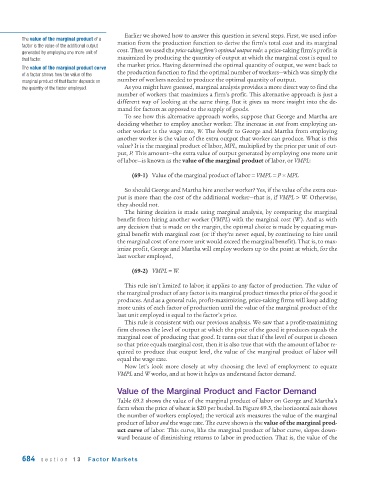Page 726 - Krugmans Economics for AP Text Book_Neat
P. 726
Earlier we showed how to answer this question in several steps. First, we used infor-
The value of the marginal product of a
mation from the production function to derive the firm’s total cost and its marginal
factor is the value of the additional output
cost. Then we used the price-taking firm’s optimal output rule: a price-taking firm’s profit is
generated by employing one more unit of
that factor. maximized by producing the quantity of output at which the marginal cost is equal to
the market price. Having determined the optimal quantity of output, we went back to
The value of the marginal product curve
the production function to find the optimal number of workers—which was simply the
of a factor shows how the value of the
marginal product of that factor depends on number of workers needed to produce the optimal quantity of output.
the quantity of the factor employed. As you might have guessed, marginal analysis provides a more direct way to find the
number of workers that maximizes a firm’s profit. This alternative approach is just a
different way of looking at the same thing. But it gives us more insight into the de-
mand for factors as opposed to the supply of goods.
To see how this alternative approach works, suppose that George and Martha are
deciding whether to employ another worker. The increase in cost from employing an-
other worker is the wage rate, W. The benefit to George and Martha from employing
another worker is the value of the extra output that worker can produce. What is this
value? It is the marginal product of labor, MPL, multiplied by the price per unit of out-
put, P. This amount—the extra value of output generated by employing one more unit
of labor—is known as the value of the marginal product of labor, or VMPL:
(69-1) Value of the marginal product of labor = VMPL = P × MPL
So should George and Martha hire another worker? Yes, if the value of the extra out-
put is more than the cost of the additional worker—that is, if VMPL > W. Otherwise,
they should not.
The hiring decision is made using marginal analysis, by comparing the marginal
benefit from hiring another worker (VMPL) with the marginal cost (W). And as with
any decision that is made on the margin, the optimal choice is made by equating mar-
ginal benefit with marginal cost (or if they’re never equal, by continuing to hire until
the marginal cost of one more unit would exceed the marginal benefit). That is, to max-
imize profit, George and Martha will employ workers up to the point at which, for the
last worker employed,
(69-2) VMPL = W.
This rule isn’t limited to labor; it applies to any factor of production. The value of
the marginal product of any factor is its marginal product times the price of the good it
produces. And as a general rule, profit-maximizing, price-taking firms will keep adding
more units of each factor of production until the value of the marginal product of the
last unit employed is equal to the factor’s price.
This rule is consistent with our previous analysis. We saw that a profit-maximizing
firm chooses the level of output at which the price of the good it produces equals the
marginal cost of producing that good. It turns out that if the level of output is chosen
so that price equals marginal cost, then it is also true that with the amount of labor re-
quired to produce that output level, the value of the marginal product of labor will
equal the wage rate.
Now let’s look more closely at why choosing the level of employment to equate
VMPL and W works, and at how it helps us understand factor demand.
Value of the Marginal Product and Factor Demand
Table 69.2 shows the value of the marginal product of labor on George and Martha’s
farm when the price of wheat is $20 per bushel. In Figure 69.3, the horizontal axis shows
the number of workers employed; the vertical axis measures the value of the marginal
product of labor and the wage rate. The curve shown is the value of the marginal prod-
uct curve of labor. This curve, like the marginal product of labor curve, slopes down-
ward because of diminishing returns to labor in production. That is, the value of the
684 section 13 Factor Markets

